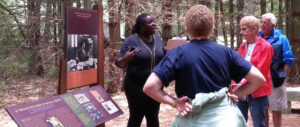The African American Heritage Trail (AAHT) touches 48 sites in 29 Massachusetts and Connecticut towns. These various self-guided experiences offer the history and context of African Americans who played pivotal roles in the region, the U.S., across the world and across the centuries. You will experience the impact and contributions of ordinary, humble people of achievement, and you will meet others who emerged as leaders and activists of their times.
Key sites include:
- The W. E. B. Du Bois Boyhood Homesite, a National Landmark property in Great Barrington
- The Rev. Samuel Harrison House in Pittsfield, home of the 54th Massachusetts Regiment chaplain who protested discriminatory pay practices.
- The Clinton Church Restoration Project, a current project, currently known as the Du Bois Freedom Center, in Great Barrington, reviving a historically Black church in Great Barrington
- The Elizabeth “Mum Bet” Trail
- At Wizard’s Glen, a cave beneath the road in Dalton was possibly used by the Underground Railroad from Lebanon Mountain. A small community of Blacks sprang up in the 1820s, in a cluster of nearly a dozen cabins. Dalton Historical Commission has restored the Fitch-Hoose House here, long believed active with the Underground Railroad.
- The Todd House, in Lanesborough, believed a station on the Underground Railroad transported the enslaved from Sand Lake, NY, in wagons used to pick up loads of sand in Lanesboro for a glass factory. Marked by a plaque on Berkshire Mall Drive.
- In Pittsfield, one of Berkshire County’s most ardent abolitionists was minister and formerly enslaved Samuel Harrison (1818–1900), who in 1850 became the first minister of the Second Congregational Church of Pittsfield, founded in 1846 as the first Black church in the county and presently located at 50 Onota Street.
- Price Memorial A. M. E. Zion Church, at 163 Linden Street, was the second predominantly Black church in Pittsfield, founded in 1958 by Fannie Cooper.
- The Berkshire County chapter of the NAACP organized in 1918.
- Trailblazing African American dancer-choreographers were introduced at the Ted Shawn Theatre, Jacob’s Pillow Dance Festival in Becket. Jacob’s Pillow is also believed to be a station on the Underground Railroad





